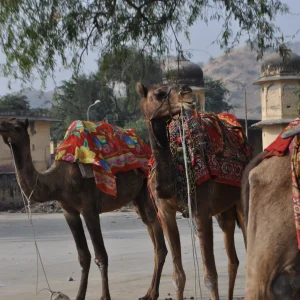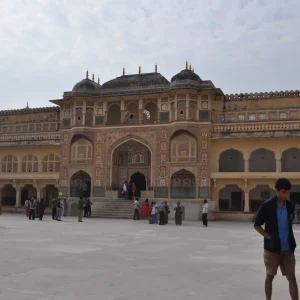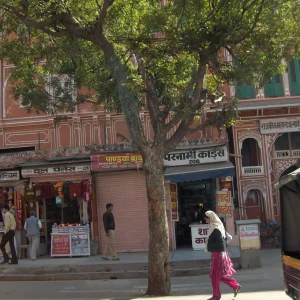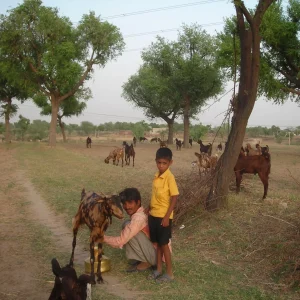36 Hours In Jaipur : Essential things to do in Rajasthan’s fabled Pink City

Day # 1
9 AM




Jaipur And Around: Storm The Citadel Of Amber
Before Maharaja Jai Singh built the pink city of his desire in the 17th century, Amber was the capital of the mighty Kachhawa Rajputs. Getting to the Amber fort – over 600 years old and Jaipur’s iconic landmark – early in the day gives you a head-start before the crowds come and make the place noisy. Budget one and a half hours for walking around the fort and visiting the various courts, halls of audience, and palaces.
Artsy Stroll Through The Old City
Savour the ancient stepwell, visit the quaint and functioning over-600-year-old Shiva temple, stroll down the main street of the ruined city for a quick look at a restored merchant home that is now a museum of blockprinting..
Nahargarh Fort – View Of The City From Royal Rooftops
The rooftop of cupolas at this fort on an adjoining hill is worth a visit just for this unique feature. Besides the spectacular views of Jaipur city far below, both from the roof and the many tiny trellised windows of the fort.
Gawk At The Lake Palace (Jal Mahal)
This is a stop to make when you come down from Amber and before you re-enter the pink walled city. Dramatically located in the centre of a lake with hills rising up as a backdrop this palace was meant for indulgent royal evenings in the hot months. It has been recently restored and will soon start functioning as a luxury restaurant that can be accessed by boat. Can be viewed from the promenade.
3 PM
Option 1: Tea at The Rambagh Palace Or Lassi At Lassiwala
If you are hungry by the end of the morning, you could try the Rambagh Palace or Lassiwala or Niro’s. The Rambagh Palace was once the royal barracks of the kings of Jaipur. Today it is a super luxury palace-hotel. Sit on the lawns and sip on a tall drink, feeling time stand still; or step into Steam, a train converted into a restaurant, for a light lunch or spicy snacks with your tea. Lassiwala on M.I.Road (next to Charmika, a tiny footwear shop) specializes in just one offering – a creamy refreshing buttermilk (rather like whipped yoghurt) that can be had either sweet or savoury. Drink your lassi out of a terracotta glass, while standing by the road-side. This uniquely north Indian drink is absolutely safe at Lassiwala. Niro’s is on M.I.Rd and is also an iconic (and safe) eatery of Jaipur that serves both vegetarian and non-vegetarian Indian and Continental food.
Option 2: Shopping
Another option is to use the afternoon to shop, or at least prospect around for what might interest you which could then be followed up on the following day. All the suggestions below have fixed prices, so you don’t have to bargain.
(i) A number of excellent and extensive warehouses – on the way back from Amber to the walled city – offer a range of select clothing, scarves, shawls and jackets, carpets and household goods, in silk, cotton and wool, using traditional Indian weaves, prints, embroidery etc. typical of different parts of India. One notable shop is Saurashtra Impex. These shops also offer a packing and courier service that will save you adding to the weight in your suitcase. Other – smaller – boutique shops for handwoven fabrics and Indian and Indo-western clothing are Nayika (M.I.Rd), Fab India (opp. Central Park); Cottons (Jacob Road) and Anokhi (Prithviraj Rd).
(ii) If your interest is in jewellery, M.I.Rd is a good place to check out. Gem Palace offers jewellery made of gold and precious stones; Amrapali specializes in chunky tribal silver jewellery and antique Rajasthani precious jewellery; while Tholia Kuber is a good place to look for silver jewellery set with semi-precious stones in both traditional Indian and modern styles. Chudi Ghar and Bangle House sell inexpensive ornamental bangles made of glass, lac, ceramic, metal and wood. All shops are within walking distance of each other on M.I.Road.
(iii) For handcrafted household goods and gifts, Soma (Jacob Rd) and Fab India (opp. Central park);
(iv) For traditional embroidered/sequined Indian footwear (jootis), Charmika near Lassiwala (M.I.Rd).
Option 3: Sanganer’s Handmade Paper And Screen Printing Workshops
Sanganer – close to Jaipur – has long been a major handicraft centre. In the old days it catered to the Jaipur royal court and the urban elite, producing fine handmade paper for illuminated manuscripts and Court documents, and delicately printed cotton textiles for the Jaipur aristocracy and temples. Today, handmade paper is still produced that is now consumed nationally and globally, while the old hand blockprinting industry that used to cater to a small clientele has largely switched to large scale screen printing for mass markets.
4 PM
Head Back To Savista
Arrive back in time to sit on the roof top with a drink, and watch the birds prepare for bed while the sun goes down over the tranquil countryside. Wrap up your day with an organic dinner by the poolside in the courtyard or under a gazebo, surrounded by candles and oil lamps, with the stars shining down undimmed by artificial light.
Day # 2
9 AM




‘Pink City’ Monuments
If you are not a committed shopper, you probably already did the walled city and its monuments yesterday afternoon, so can choose to rest and relax at Savista on Day 2 of your stay. Alternatively, you could do those today. Set out wearing your hat, sunglasses and walking shoes for the walled city to mop up the rest of the monuments. You could then either take a walking tour through the energy-filled streets or complete your shopping, or simply wrap up your day and return to the quiet of the countryside.
The most essential monuments that require some time – and are within walking distance of each other – are the City Palace and the Jantar Mantar (one of five observatories across north India built by the astronomer-king Jai Singh who established the city of Jaipur). The third – Hawa Mahal (Palace of the Winds), a faux palace that is actually a heavily embellished sandstone screen with hundreds of tiny windows through which the veiled royal ladies would wistfully watch the lives of commoners go by – is on one of the most colourful streets of the walled city, entirely packaged for tourists with handicraft shops and pushy merchants.
12 PM
Option 1: Street Walk
If you are the energetic type and feel you would like to get beneath the mere surface of the walled city, you could book to join an organized walk conducted by a knowledgeable English speaking local who will introduce you to spice streets, or temples or merchant havelis – depending on your choice – that are off the tourist track, that you would have never guessed existed. Or you could do a visual tour on your own by cycle rickshaw.
Option 2: Cycle Rickshaw Ride Around Walled City
This is an excellent way to do the walled city without having to negotiate the crowds and traffic on the road. Get the rickshaw driver to lower the hood so you can look around and take in the interesting and beautiful architecture of what was conceived by Maharajah Jai Singh – the city’s founder – as a trading-cum-residential urban centre
2 PM
Visit Bagru Hand Blockprinting Village
Head back in the direction of Savista. Freshen up and then proceed to the village of Bagru (10 km beyond Savista) through beautiful countryside to visit little workshops owned and run by families that have been doing hand blockprinting as a hereditary occupation for more than five generations. What is different about Bagru (in comparison with Sanganer) is that textile printing here continues to use the same 350 year old techniques (handcarved wooden blocks, natural colours and dyes, home based workshops). Watch how beautiful, colourful and intricate prints are created on cotton and silk. Buying here – printed fabric (stoles, scarves, duvets, cushion covers; wooden blocks as souvenirs) – has the benefit of putting money directly in the hands of the craftspersons.
5 PM
Return To Savista For The Evening And Dinner
Day # 3
11 AM




Camel Cart Ride
After a lazy sleep-in followed by breakfast, schedule a camel cart ride through the bucolic countryside and hamlets. Relax on cushions and jump off wherever you feel like stopping. Let the camel cart driver take you into people’s homes where you will be warmly welcomed with brilliant smiles, hot chai and inquisitive children who like to be photographed.
2 PM
Return To Savista For Lunch. Relax By The Poolside Or On The Roof
4 PM
Cross Country Walk or Bike Ride
Walk or bike through/past fields rich with young crops, pass farmers’ houses and yards with munching buffaloes and frisky goats, be greeted by friendly ordinary villagers and small children whose English vocabulary does not extend beyond “bye bye”, “hello” and “what is your name?” This is village India at its best!
6 PM
Return To Savista For Drinks And Dinner
